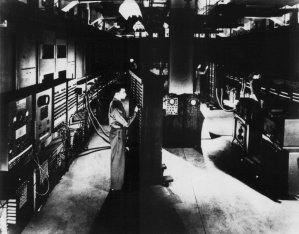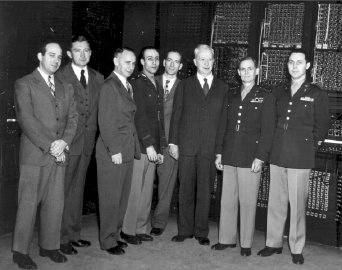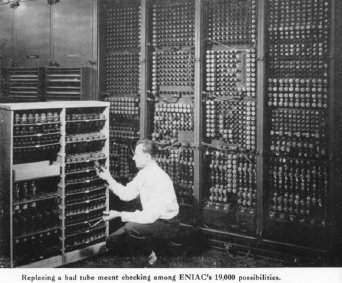|
|
|
|
|
|
|
|
|
|
|
|
|
|
|
|
|
|
|
|
|
|
|
|
|
|
|
|
|
|
|
|
|
|
|
|
|
|
|
|
|
|
|
|
 |
|
|
|
|
|
|
|
|
|
|
|
|
|
|
|
|
|
|
|
|
|
|
|
|
|
|
|
|
|
|
|
|
|
|
|
|
|
|
|
|
|
|
|
|
|
|
|
|
|
|
|
|
|
|
|
|
|
|
|
|
|
|
|
|
|
|
|
|
|
|
| Computadores
para Cálculo Cíentifico |
|
|
|
|
|
|
|
|
|
|
|
|
|
|
|
|
|
|
|
|
|
|
|
|
|
|
|
|
|
|
|
|
|
|
|
|
|
|
|
|
|
Important
ENIAC Dates
The original press conference announcing the ENIAC was held on 1
February, 1946. The reporters were addressed by Major General Gladeon
M. Barnes, head of Research and Development Service of the Office
of the Chief of Ordnance, Eckert, Mauchly, Brainerd, and Goldstine.
Arthur Burks and Kite Sharpless conducted a formal ENIAC demonstration
showing five simple problems:
1.
5,000 additions in one second
2. 50 multiplications in one second
3. Generation of squares and cubes
4. Generation of sine and cosine table, to be tabulated
5. A more complicated computation
The formal dedication and dinner held in Penn's Houston Hall. Penn
President McClelland presided, the principal speaker was Dr. Frank
Jewett, president of the National Academy of Sciences. General Barnes
carried out the actual dedication; after giving a short speech,
he pressed a button that turned on the ENIAC. Guests then went to
the Moore school to see the actual demonstration.
The date was 15 February, 1946.
Both
of these historical events are documented in Herman H. Goldstine,
"The Computer from Pascal to von Neumann" , Princeton
University Press, 1993 ISBN 0-691-02367-0 (paperback), pages 227
and following.
|
|
|
|
|
 |
|
|
Eniac - 1946
|
| Foto
do Exército dos EUA |
|
|
|
|
|
|
|
|
|
|
|
|
|
|
|
|
|
 |
|
| Fotografia
Oficial da Equipa Eniac |
| Da esquerda
para a direita: J. Presper Eckert,
Jr., Chief Engineer; Professor J. G. Brainerd, Supervisor; Sam Feltman,
Chief Engineer for Ballistics, Ordnance Department; Captain H. H.
Goldstine, Liaison Officer; Dr. J. W. Mauchly, Consulting Engineer;
Dean Harold Pender, Moore School of Electrical Engineering, University
of Pennsylvania; General G. M. Barnes, Chief of the Ordnance Research
and Development Service; Colonel Paul N. Gillon, Chief, Research Branch
of the Army Ordnance Research and Development Service. |
|
|
|
|
|
|
|
|
|
|
|
|
|
|
|
|
|
|
|
Embora
estivesse operacional em Novembro de 1945, o ENIAC (Electronic
Numerical Integrator and Computer) só foi oficialmente
apresentado em Fevereiro de1946.
O ENIAC resulta dos trabalhos realizados por uma equipa da
Moore School da Universidade de Pensilvânia após esta
ter assinado a 5 de Junho de 1943 um contrato com o Governo dos U.S.A.
para a sua construção.
A equipa coordenada por Herman Goldstine contava com
John Eckert, John Mauchly e, a partir de 7 de Agosto de 1944, com
a colaboração de John von Neumann . Os trabalhos têm
por base uma máquina que John
Atanasoff tinha começado a construir em 1937, um calculador
com 240 válvulas e duas memórias tambor. |
|
|
|
|
|
|
|
|
|
|
|
|
|
|
|
|
|
|
|
|
|
|
|
|
|
|
|
|
No
entanto, o relatório elaborado por von Neumann em 30 de Junho
de 1945, First draft of a report on the EDVAC, propõe
a adopção de uma nova arquitectura - hoje canónica
-, para estes tipo de calculadores. O EDVAC - Electronic
Discrete Variable Automatic Computer - consubstanciaria esta proposta.
Embora Mauchly e Eckert tenham começado a construir o EDVAC,
com a ajuda de von Neumann, o projecto nunca foi terminado.
O ENIAC dispunha de 18.800 válvulas de 16 tipos diferentes,
6.000 comutadores, 10.000 condensadores, 1.500 relais, e 50.000 resistencias.
Ocupava 3 salas com um total de 72 metros quadrados, era refrigerado
por dois ventiladores movidos por motores Chrysler de 12 CV e tinha
uma massa de cerca de 30 toneladas. Consta que, em média, tinha
uma avaria em cada 6 horas de funcionamento.
Sabe-se hoje que na mesma época em Inglaterra, no mais absoluto
segredo, Alan Turing coordenava
a construção de calculadores electromecânicos
semelhantes, destinados a decifrar as mensagens das Forças
Armadas Alemãs. Por sua vez, na Alemanha Konrad
Zuse construia, sem grandes apoios oficiais, calculadores electomecânicos
para cálculo de armamento da Força Aérea Alemã.
|
|
|
 |
|
 |
|
|
| Vista
do lado esquerdo do ENIAC |
|
|
|
|
|
|
|
|
Vista do
lado direito do ENIAC
Duas senhoras reprogramando a cablagem do ENIAC |
|
|
|
|
|
|
|
|
|
|
|
|
|
|
|
|
 |
|
| Substituindo
uma válvula no ENIAC:
Para substituir uma válvula no ENIAC era necessário
realizar testes entre 19.000 possibilidades de avaria. |
|
|
|
|
|
|
|
|
|
|
|
|
|
|
|
|
|
|
|
|
|
|
|
|
|
|
|
|





